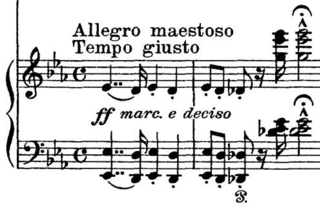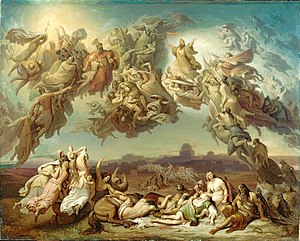
Franz Liszt was a Hungarian composer, pianist and teacher of the Romantic era.
A symphonic poem or tone poem is a piece of orchestral music, usually in a single continuous movement, which illustrates or evokes the content of a poem, short story, novel, painting, landscape, or other (non-musical) source. The German term Tondichtung appears to have been first used by the composer Carl Loewe in 1828. The Hungarian composer Franz Liszt first applied the term Symphonische Dichtung to his 13 works in this vein.
The "War of the Romantics" is a term used by some music historians to describe the schism among prominent musicians in the second half of the 19th century. Musical structure, the limits of chromatic harmony, and program music versus absolute music were the principal areas of contention. The opposing parties crystallized during the 1850s. The most prominent members of the conservative circle were Johannes Brahms, Joseph Joachim, Clara Schumann, and the Leipzig Conservatoire which had been founded by Felix Mendelssohn. Their opponents, the radical progressives mainly from Weimar, were represented by Franz Liszt and the members of the so-called New German School, and by Richard Wagner. The controversy was German and Central European in origin; musicians from France, Italy, and Russia were only marginally involved. Composers from both sides looked back on Beethoven as their spiritual and artistic hero; the conservatives seeing him as an unsurpassable peak, the progressives as a new beginning in music.
A Faust Symphony in three character pictures, S.108, or simply the "Faust Symphony", is a choral symphony written by Hungarian composer Franz Liszt inspired by Johann Wolfgang von Goethe's drama, Faust. The symphony was premiered in Weimar on 5 September 1857, for the inauguration of the Goethe–Schiller Monument there.

Franz Liszt composed his Piano Concerto No. 1 in E♭ major, S.124 over a 26-year period; the main themes date from 1830, while the final version is dated 1849. The concerto consists of four movements and lasts approximately 20 minutes. It premiered in Weimar on February 17, 1855, with Liszt at the piano and Hector Berlioz conducting.
A Symphony to Dante's Divine Comedy, S.109, or simply the "Dante Symphony", is a choral symphony composed by Franz Liszt. Written in the high romantic style, it is based on Dante Alighieri's journey through Hell and Purgatory, as depicted in The Divine Comedy. It was premiered in Dresden in November 1857, with Liszt conducting himself, and was unofficially dedicated to the composer's friend and future son-in-law Richard Wagner. The entire symphony takes approximately 50 minutes to perform. It premiered on 7 November 1857.
Franz Liszt wrote drafts for his Concerto for Piano and Orchestra No. 2 in A major, S.125, during his virtuoso period, in 1839 to 1840. He then put away the manuscript for a decade. When he returned to the concerto, he revised and scrutinized it repeatedly. The fourth and final period of revision ended in 1861. Liszt dedicated the work to his student Hans von Bronsart, who gave the first performance, with Liszt conducting, in Weimar on January 7, 1857.

Les préludes, S.97, is the third of Franz Liszt's thirteen symphonic poems. The music was composed between 1845–54, and began as an overture to Liszt's choral cycle Les quatre élémens, then revised as a standing alone concert overture, with a new title referring to a poem by Alphonse de Lamartine. Its premiere was on 23 February 1854, conducted by Liszt himself. The score was published in 1856 by Breitkopf & Härtel. Les préludes is the earliest example of an orchestral work entitled "Symphonic Poem".

The Sonata on the 94th Psalm in C minor is a sonata for solo organ by Julius Reubke, based on the text of Psalm 94. It is considered one of the pinnacles of the Romantic repertoire.

The symphonic poems of the Hungarian composer Franz Liszt are a series of 13 orchestral works, numbered S.95–107. The first 12 were composed between 1848 and 1858 ; the last, Von der Wiege bis zum Grabe, followed in 1882. These works helped establish the genre of orchestral program music—compositions written to illustrate an extra-musical plan derived from a play, poem, painting or work of nature. They inspired the symphonic poems of Bedřich Smetana, Antonín Dvořák, Richard Strauss and others.
(Die) Hunnenschlacht may refer to:

Franz Liszt composed his Prometheus in 1850, numbering it No. 5 in his cycle of symphonic poems when he revised it in 1855. The work is based on the Greek myth detailing the Titan Prometheus' theft of fire from the gods and is numbered S.99 in the Searle catalogue.
Thematic transformation is a musical technique in which a leitmotif, or theme, is developed by changing the theme by using permutation, augmentation, diminution, and fragmentation. It was primarily developed by Franz Liszt and Hector Berlioz. The technique is essentially one of variation. A basic theme is reprised throughout a musical work, but it undergoes constant transformations and disguises and is made to appear in several contrasting roles. However, the transformations of this theme will always serve the purpose of "unity within variety" that was the architectural role of sonata form in the classical symphony. The difference here is that thematic transformation can accommodate the dramatically charged phrases, highly coloured melodies and atmospheric harmonies favored by the Romantic composers, whereas sonata form was geared more toward the more objective characteristics of absolute music. Also, while thematic transformation is similar to variation, the effect is usually different since the transformed theme has a life of its own and is no longer a sibling to the original theme.
Orpheus is a symphonic poem written by Franz Liszt in 1853–54. He numbered it No. 4 in the cycle of 12 he wrote during his time in Weimar, Germany. It was first performed on 16 February 1854, conducted by the composer, as an introduction to the first Weimar performance of Christoph Willibald Gluck's opera Orfeo ed Euridice. The performance helped celebrate the birthday of Weimar's Grand Duchess Maria Pavlovna, who was an amateur musician and a staunch supporter of Liszt at Weimar.
Franz Liszt composed his Tasso: lamento e trionfo in 1849, revising it in 1850–51 and again in 1854. It is numbered No. 2 in his cycle of 13 symphonic poems written during his Weimar period.

Franz Liszt wrote his symphonic poem Hungaria in 1854, basing it partly on the Heroic March in the Hungarian Style for piano which he wrote in 1840. It was premiered under Liszt's baton at the Hungarian National Theater in Budapest on September 8, 1856, where it achieved an enormous success. "There was better than applause," the composer later wrote. "All wept, both men and women!" He was reminded with that scene of the proverb that "tears are the joy of the Hungarians."
Mazeppa is a symphonic poem composed by Franz Liszt between the years 1851 to 1854 for orchestra. Mazeppa, S. 100, is the sixth in the cycle of twelve symphonic poems written during Liszt's time in Weimar, however a thirteenth composition was added to his collection in 1882. Mazeppa is based on the poem of the same title written by Victor Hugo in 1829. The work premiered at the Court Theatre in Weimar on April 16, 1854.

Hakon Jarl is a symphonic poem in C minor composed by Bedřich Smetana between 1860 and 1861. It is based on the historical tragedy of the same name by the Danish poet and playwright Adam Oehlenschläger. The play's protagonist and namesake is Håkon Jarl who ruled Norway in the late 10th century.

Festklänge, S. 101, is the seventh symphonic poem by Franz Liszt. Written in 1853 during Liszt's time in Weimar, it was first performed on 9 November 1854 and was published in 1857. The German title means "festive sounds", and Liszt had intended the piece to be played at his wedding to Princess Carolyne zu Sayn-Wittgenstein.

Héroïde funèbre, S. 102, is a symphonic poem written by Franz Liszt in 1850 and published in 1857 as No. 8. The work originated as the first movement of a planned Revolutionary Symphony inspired by the July Revolution. Liszt pays homage in this programmatic symphonic poem to the soldiers and men that died fighting in revolutionary efforts. The composition of this piece was started in 1830 as a brief sketch for a full symphony, but was dropped by Liszt in the continuing of other works. However, in 1848, there was an uprising in Liszt's home country of Hungary. One of Liszt's friends was killed during this revolution, which caused Liszt to revisit his now 20 year old sketch of the Revolutionary Symphony, shortening it and forming the first movement into the commemorative Héroïde funèbre. Liszt said of the program, "In these successive wars and carnages, sinister sports, whatever be the colours of the flags which rise proudly and boldly against each other, on both sides they float soaked with heroic blood and inexhaustible tears. It is for Art to throw her ennobling veil over the tomb of the brave, to encircle with her golden halo the dead and dying, that they may be the envy of the living."










